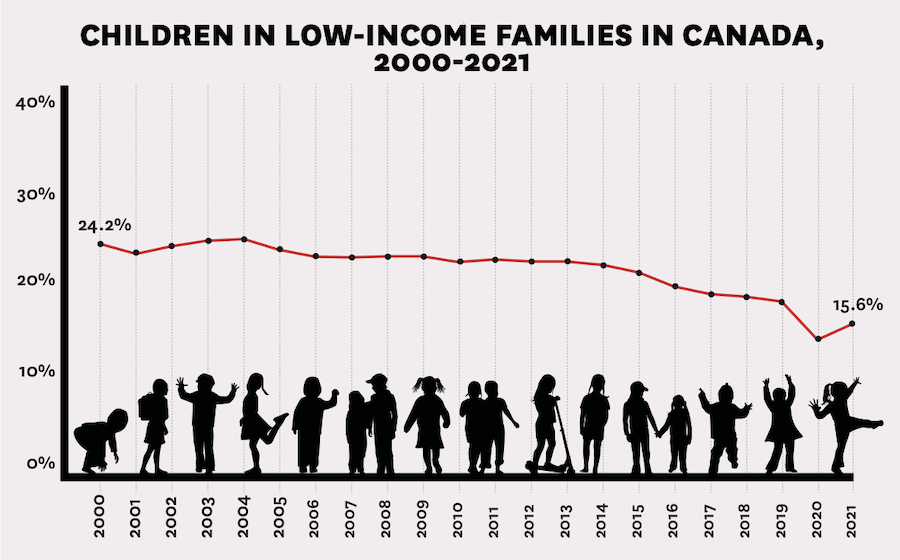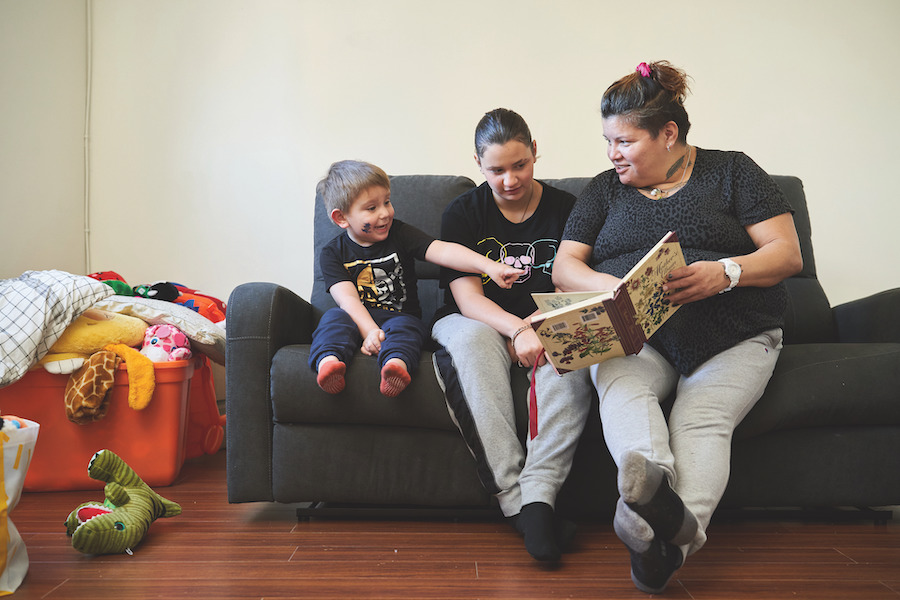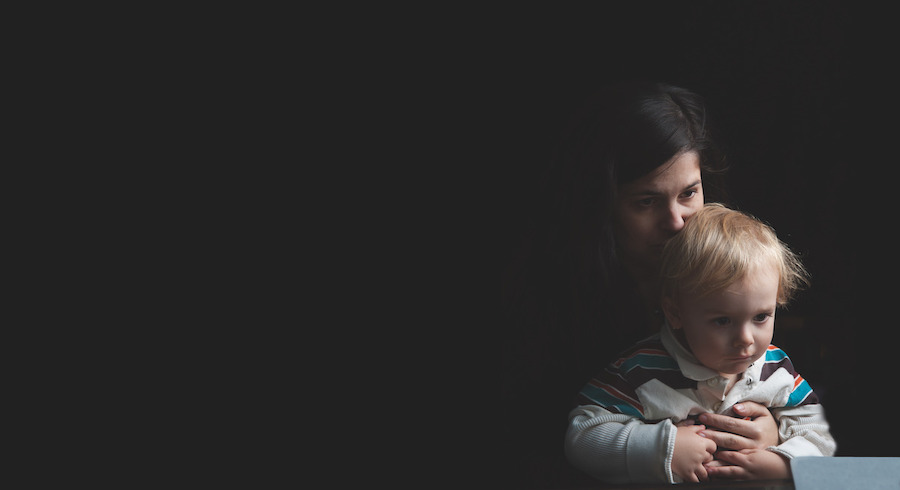Poverty is pain: the ache in your belly after you finish the bag of Doritos you brought to school for lunch. Poverty is shame: your classmates’ laughter at your crooked teeth because your parents can’t afford to get them fixed. Poverty is brain fog: its stresses reduce a person’s ability to solve problems or make good decisions. Poverty is sickness: it increases a child’s likelihood of experiencing heart disease or diabetes as an adult. Poverty is anxiety: it’s not knowing where you’re going to sleep as your family moves from one unsanitary apartment to another. Poverty is despair: suicide rates in low-income areas are higher than in other areas. Poverty is death: a person who grew up in poverty can expect to die up to eight years sooner than the average Canadian.
In Canada, where there is enough for all, the persistence of child poverty should shame us. It is also a burden on our economy and on our systems of justice, education and health. Child poverty costs everyone.
You may unsubscribe from any of our newsletters at any time.
But child poverty can be solved. In 1989, Parliament voted unanimously on a resolution to end child poverty in Canada by the year 2000. We’re 24 years past deadline. A graph of child poverty rates in Canada from 1989 to 2021 resembles, for the most part, a near-horizontal line with a slight but stubbornly optimistic downward trend. Two irregularities in that graph are worth paying attention to.
The first is a decisive tilt downward between 2015 and 2016. The Liberal federal government introduced the Canada Child Benefit in 2016, replacing previous family benefit programs and putting significant non-taxable income into the pockets of Canadian parents. Between 2015 and 2019, child poverty in Canada fell from 20.9 percent to 17.7 percent.*
The second anomaly in the graph is a sharp drop from 2019 to 2020. In a single year, child poverty in Canada fell from 17.7 percent to 13.5 percent, the largest year-over-year drop since the eradication efforts began in 1989. This happy outcome occurred by accident, a side-effect of the government’s pandemic response. The results may have been inadvertent, but anti-poverty advocates are seeing a solution in them for Canada’s poorest kids.

Meaghan Erbus has a frontline view of hunger in a province with one of the highest child poverty rates in Canada. She works at Harvest Manitoba, a food bank network that distributes groceries to more than 100,000 Manitobans each month. During the first panicky weeks of the COVID-19 pandemic, the number of people using food banks surged while donations dwindled and volunteers vanished. Harvest Manitoba nearly closed its doors. An emergency fundraiser by the Winnipeg Jets hockey team helped. But then something surprising happened. Food bank use hit a plateau and then began to drop. At first Erbus didn’t understand what was going on. The pandemic was still rampaging around the globe. Businesses were closed. People were unemployed. We were all in crisis mode. Then she figured it out.
In March 2020, the federal government rolled out one of the swiftest and most effective anti-poverty measures in Canadian history. Of course, that’s not how it was intended. The Canada Emergency Response Benefit (CERB) was created to keep Canadians afloat during a massive economic shutdown and prevent an even deeper crisis. CERB gave people $500 a week — the amount of money the government figured the average Canadian needed to pay rent and buy groceries and other essentials.
It turned out that $500 a week was a fair bit more than what hundreds of thousands of Canadians were already getting by on. It was more than many people were earning at part-time minimum wage jobs or receiving in employment insurance, social assistance or disability payments. For the poorest 10 percent of families, CERB more than replaced their lost income; it was a net increase.
CERB was also much easier to apply for than other forms of government assistance. All you needed to do was fill out a form attesting that you’d lost work, and within a week the money started arriving in your bank account. (It didn’t reach everyone. People who didn’t earn an income in 2019, undocumented people and migrant workers without social insurance numbers were left out.)
Between March and September 2020, nearly nine million Canadians received CERB. The highest CERB draws were in some of the country’s poorest neighbourhoods. And there, the money had an outsized effect. During the pandemic, poverty rates declined among all ages, but especially among children. The largest drops happened in places with the most severe child poverty: Nunavut, northern Manitoba and northern Saskatchewan. In a single year, 314,290 children — nearly a quarter of the number living in poverty — were lifted above the poverty line.
“People who had spent their whole life in poverty, struggling, were finally able to make ends meet,” says Michael Redhead Champagne, an anti-poverty advocate who lives and works in Winnipeg’s North End, a neighbourhood with one of the highest levels of child poverty in Canada. “It was nice to see, for a moment, people having money for rent, having money for food, having space and time to focus on mental health and paying down debts.”
Barbara Beardy is a Cree woman in her mid-40s who has lived on and off the streets of Winnipeg since she was 14. She faces the world with a determined gaze, but her eyes soften when she speaks about her children or grandchildren. Beardy used her first CERB payment to buy a train ticket to her home community of Thicket Portage so she could bury the ashes of twins she’d miscarried. The income also allowed her to catch up on her phone bills and buy groceries and clothing for her 15-year-old daughter.
And then CERB ended.
***
More on Broadview:
- How one community leader is fighting for food security in Newfoundland and Labrador
- The billions we spend on our pets could fight global poverty instead
- Food banks should not exist
The gains made during the pandemic are likely temporary. The Liberal government introduced a poverty reduction strategy in 2018, and Prime Minister Justin Trudeau took a moment in 2020 to celebrate his government’s success at lifting a million Canadians out of poverty. But that success is unlikely to last. The numbers for 2021 show child poverty rates beginning to angle up again as some of the pandemic benefits expired. Leila Sarangi, director of Campaign 2000, a coalition of organizations working to end child poverty in Canada, expects to see those numbers continue to climb when Statistics Canada releases data from 2022 and 2023, coinciding with the end of all remaining pandemic benefits.
Instead of extending the benefits to continue helping low-income families, the government set out to claw some back. Ottawa has been under pressure to recoup billions of dollars claimed by ineligible recipients. Eligibility requirements for CERB posted on government websites were notoriously difficult to decipher. Some applicants made mistakes during a stressful time. Women, racialized workers, Indigenous people and precariously employed people were more likely to apply for CERB, and many in those demographics have been receiving letters demanding repayment of tens of thousands of dollars they have already spent.
“People are really scared,” says Sarangi. “They’re skipping meals and going without medication so they can make these payments… The mental health piece around this is just heartbreaking.”
Marisolle Negash, who works at Acorn Family Place, a drop-in for parents and children in Winnipeg’s downtown, recently took a call from an unemployed parent who had misunderstood the eligibility requirements for CERB and now owes $20,000. The parent is looking for a job but currently has no leads.
Meanwhile, rising costs of food and housing have plunged many families back into deeper poverty. Between 2020 and 2021, child poverty rates rebounded from 13.5 percent to 15.6 percent. The number of families in Canada using food banks is at a historic high. Two million people are relying on them to get by every month. A third are children. A quarter of people receiving food from Harvest Manitoba have jobs and still can’t afford groceries.
Rent is rising faster than at any time since the 1990s, says David Macdonald, senior economist at the Canadian Centre for Policy Alternatives in Ottawa. It’s gone up an average of 20 percent since the pandemic. Four provinces and the territories have no laws limiting how much landlords can raise the rent.
After her CERB payments ended, Beardy went back to living on the street. She was using drugs and alcohol to numb the pain she felt after the deaths of her twins. “I lost everything,” she says.

Eventually, Beardy decided to stop using. She spent two weeks detoxing on her adult daughter’s couch. She managed to find a quiet apartment to rent (“no roughhousing, no people sleeping in the hallway, no meth heads”), which the landlord generously agreed to let her have for $850 a month because she was clean. Beardy regained custody of her 15-year-old daughter. She’s taking classes to become an addictions counsellor and looks after her young grandson while her adult daughter works long hours at a garage. Beardy says her daughter would rather be at home with her child, but social assistance doesn’t provide enough for stable housing. “Welfare gives you $532. So you got to resort to living in a rooming house with a bunch of meth heads? Just, no!” Beardy’s 15-year-old daughter wants them to move out of Winnipeg’s inner city. The teen has her eye on a two-bedroom apartment next to a high school in a suburban neighbourhood, but $1,300 a month in rent is impossible on their budget, Beardy says.
Food, housing, mental health support, transportation and safety are the top priorities for parents in Winnipeg’s core, says Negash. The drop-in she staffs is in a red-brick building that’s also home to a soup kitchen, Young United Church and a housing co-op for people living with HIV or AIDS.
Negash helps parents navigate a labyrinth of websites, forms and phone calls to apply for different types of government assistance. She advocates with social workers, doctors, landlords and government officials.
People in poverty try to look out for each other, Negash says. Recently she answered a call from a young father facing eviction. He was worried about what would happen to the neighbourhood children who took refuge at his house. Negash says some parents leave a portion of the groceries they receive from
Harvest Manitoba in the elevators of their apartment buildings for unsheltered people, returning the kind gesture they, too, have sometimes been offered.
“Poverty is at the heart of all of these issues,” says Emma Fineblit, executive director of Acorn Family Place. “If people had enough income to meet their daily needs, they wouldn’t be spending their lives in survival mode bouncing from resource to resource to collect a bit of food here and a bit of food there.”
***
The pandemic response showed us what works, says Sarangi of Campaign 2000. Poverty is complex and solving it will involve more than putting money in people’s pockets. That said, government cash to poor families is where an anti-poverty strategy needs to start.
The first step is to grant CERB amnesty to anyone below the poverty line, says Sarangi. “We should immediately stop asking them for money back and stop chasing them, because the kind of stress and anxiety we’re causing is really awful.”
Even families who aren’t facing repayment may have had their Child Canada Benefit reduced because CERB temporarily boosted their income. Sarangi says this needs to stop too.
But those measures are only a start. Campaign 2000, which launched in 1991, two years after the parliamentary vote to end child poverty, has a blueprint for much greater success. Its most recent annual report card contains 50 recommendations for income-security measures, decent jobs and social supports.
Near the top of the list is a $6.4-billion supplement to the Canada Child Benefit. Campaign 2000’s research shows that the benefit is losing its power to boost children out of poverty. It doesn’t reach families in deep poverty or parents without legal status. Augmenting it would reduce child poverty significantly.
Another relatively simple step would be for the government to repeal the section of the Income Tax Act that prevents parents with precarious immigration status (who nevertheless pay taxes) from receiving the Canada Child Benefit.
Campaign 2000 also wants the government to increase the Canada Social Transfer — the block fund the federal government gives to provinces and territories for social and disability assistance programs, education and childcare. That money also needs to be better accounted for. “The provinces and territories never have to report back what they’re doing with that money,” says Sarangi, “and it’s one of the reasons social assistance rates remain so devastatingly low.” Social assistance programs in their current form lock people into poverty instead of helping them get out, she says. “You work, and they claw it back; it becomes really impossible to create your own safety net and get out.”
Campaign 2000 is also asking the government to pilot a program that would help people who don’t file income tax returns. Many people in poverty don’t file because they lack a fixed address, are suffering from mental health issues or are fleeing domestic violence. Without a tax return, they can’t apply for government benefits. Other countries have successfully implemented systems to get cash to marginalized people who don’t file returns through trusted community organizations. Canada could do the same.
Indigenous families experience higher rates of poverty than non-Indigenous families, especially in northern communities that don’t have the same networks of shelters, food banks and drop-ins that urban centres do. Eradicating child poverty would involve the federal government collaborating closely with First Nations, Inuit and Métis governments and organizations.
Campaign 2000’s report card asks for higher minimum wages, reforms to employment insurance to make it more comprehensive and easier to apply for, and daycare available at a sliding scale from $0 to $10 a day. Other measures: better housing for unhoused people, for women fleeing domestic violence and for First Nations, Inuit and Métis communities.
Ending child poverty is not only attainable — it’s also affordable. Matthew Desmond, a Princeton sociologist and Pulitzer Prize-winning author who grew up in poverty himself, makes this argument in his 2023 book, Poverty, By America. He characterizes his country as a welfare state for the rich. If we’re handing out subsidies to the wealthy in the form of tax breaks, he argues, we have no excuse not to invest in ending poverty.
Here’s some math: in 2022, the Manitoba government introduced a suite of measures called the Family Affordability Package, $63.6 million of which was designated to help struggling families. Every family earning up to $175,000 received a one-time payment of $250 for one child and $200 for each subsequent child. A family earning six figures didn’t need that money, and for the poorest families, it wasn’t enough. If the funding had been targeted to the families who needed it most, it would have had a much bigger impact.
At the same time, the province handed out nearly $350 mil- lion in school tax rebates to property owners. These rebates only helped people who owned property; families too poor to own homes didn’t benefit.
A Campaign 2000 study shows that the provincial government could have spent the same amount of money on those who needed it most and lifted 86 percent of children from low-income households out of poverty — that’s 44,720 kids. The affordability package in its current form lifted only an estimated three percent, or 1,352 children.
When everyone receives what they need to live with dignity, the benefits extend to all of us. Studies show that more equal societies have healthier and happier residents with better mental health, lower drug use, longer life expectancy, more social trust and stronger democratic engagement. Children across the board are healthier and happier in more equal countries. Among developed nations, the well-being of children has more to do with how equal a society is than its overall wealth.
In Poverty, By America, Desmond asks why we don’t take the necessary steps to abolish poverty. It’s not because we lack the resources, he says. Poverty persists because we let it. To those people who shake their heads and ask how we can afford it, Desmond responds with a preacher’s rebuke: “What a sinful question.”
It was seeing her newborn grandson for the first time that gave Barbara Beardy the impetus to kick her addictions. But she wouldn’t have been able to find stability without the mini- mal support provided by government assistance plus the help of a generous landlord. Many others aren’t so fortunate. The safety net we’ve woven for our most vulnerable is still riddled with holes. Beardy doesn’t want her grandson to grow up in poverty the way she did. “Those kids are the future,” she says. “If we want to keep the society going, we need to help those children.”
***
Josiah Neufeld is a journalist and author in Winnipeg.
This story first appeared in Broadview’s March 2024 issue with the title “It Takes a Village.”














Thanks for giving this wonderful Broadview article extra exposure through posting on electronic media.
This article by Josiah Neufeld, together with “The Dauphin Experiment” (Broadview, March 2024) is one that calls upon each reader for action. “Poverty exists because we let it.” (Neufeld) We could make a difference and lift thousands of children, youth and adults (including Seniors) out of poverty, if each reader wrote to their MP, Prime Minister, Deputy Prime Minister and Senators, beseeching them to implement a Guaranteed Livable Basic Income in our country. Thanks to the writers, to Broadview and to John and Lillian Perigoe for bringing Poverty, the highest social determinent to health, to our attention for action and change.
I’ve thought a lot about poverty over the years. First of all: “Child Poverty” is a misnomer. Children do not earn money. It is their parents that live in poverty and therefore unable to properly support them. Increasing minimum wage doesn’t work because business will just increase prices of food and services accordingly. As well, the idea of living simply has gone out the window. People feel that they are deserving of all the things their peers and neighbours have and that’s where much of the money goes. And, let’s not forget the money that governments make from alcohol, gambling and other vices that attract those unable to control their compulsions. If a living wage or salary is given to someone their lack of responsibility will figure…”I can buy these tickets, or this alcohol, or this TV and still get food at the food bank.” And I know not everything thinks this way but it happens and many folks won’t say it for fear of being ostracized but in my 75 years on earth I’ve seen this mindset. Poverty will not end. It’s always been with us and always will be. Sorry but that’s just part of my opinion.